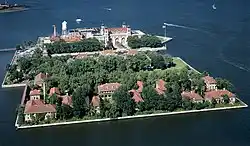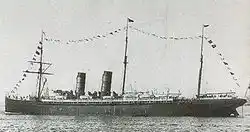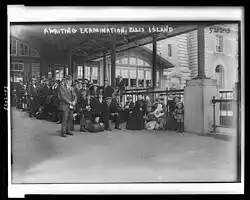
European immigration to the Americas is a process that has played out in one form or another since the discovery of the Americas by Christopher Columbus for Spain in 1492. For a century thereafter European immigration was largely confined to the Spanish colonies in the Caribbean, Mexico and parts of South America such as Colombia, Bolivia and Peru. From early in the seventeenth century other European powers began planting colonies in the Caribbean and North America, notably England and France. Colonial settlement continued for two centuries thereafter, but the nature of European immigration changed in the nineteenth century. Firstly, independent nations such as the United States, Mexico, Gran Columbia, Peru and Argentina emerged out of the colonies. Secondly, the advent of the steamships and the explosion of population levels in Europe owing to industrialization and the advent of modern medicine saw tens of millions of Europeans leave the Old World for the New between the 1820s and the 1920s. European immigration has continued down to the present day, but the scale of it declined enormously from the 1920s onwards.[1]
European immigration to the Americas chronology of eventsEuropean immigration to the Americas chronology of events

Europeans had discovered the Americas long before 1492, specifically when the Norse explorers settled colonies on Greenland and Newfoundland at the beginning of the eleventh century. Still, it was not until Columbus landed in the Caribbean in 1492 and John Cabot arrived to the mainland of North America in 1497 that colonization on any major scale began. Even then it was really only the Spanish that were engaged in it for most of the next century.[2] The English, French, Portuguese and Dutch were certainly exploring the Americas and making tentative efforts at colonizing parts of North and South America in the sixteenth century, though with little tangible impact. Then, all of a sudden, in the early seventeenth century, all of these countries became much more active. England established its first colonies on the North American mainland in Virginia and New England, France established colonies along the course of the St Lawrence River in Canada and the Dutch settled Manhattan Island and up the Hudson River in what subsequently became New York. There was a general rush to begin acquiring islands no matter how small they might be in the Caribbean once it was realized how great the profits from sugar cane cultivation there could be.[3]
This formed the basis for European immigration for the entirety of the sixteenth, seventeenth and eighteenth centuries. The Spanish had major settlements in the Caribbean on Cuba, Hispaniola and other islands, as well as in parts of Central and South America like Mexico, Peru and the mouth of the Rio de la Plata. The English and French were dominant on the eastern seaboard of North America, the Portuguese in Brazil and several countries in the Caribbean. Generally speaking immigrants came from the mother country in Europe to the colonies in the Americas. There was little diversity. One might find a Pole or a Hungarian here and there, but generally speaking the Spanish colonies were inhabited by Spaniards, the English colonies by English, Welsh, Scottish and Irish settlers and so forth.[4]

Everything changed in the nineteenth century. One of the key factors was that the colonies began to acquire independence from the metropolitan governments back home and once they did so the range of people they welcomed from Europe broadened. More importantly, societal changes back home in Europe led to an enormous population boom, specifically because of the introduction of vaccines and the declining rate of child mortality.[5] This combined with the advent of the steamships and the railways from the 1830s onwards to make it much more feasible for mass migration across the Atlantic Ocean to the thinly populated western hemisphere to take place. Some ships like the RMS Umbria and Etruria run by the Cunard Line in the 1880s, 1890s and 1900s would carry hundreds of thousands of people from Europe to live in the Americas during their years of service. The result was one of the largest mass migrations in human history between 1820 and 1920. Thereafter European immigration slowed drastically as birth rates plummeted in Europe and the two world wars led to a shortage of labor in the Old World.[6]
Extent of European immigration to the AmericasExtent of European immigration to the Americas
The extent of European migration to the New World changed considerably from period to period and was occurring in different regions at different times. In the sixteenth century it was nearly all occurring from Spain to places like Hispaniola and Cuba in the Caribbean and to Mexico, Columbia and Peru in Central and South America. It is estimated that about a quarter of a million people left Spain for the New World in the first century after Columbus first discovered the new continent.[7] The scale of migration increased in the course of the seventeenth and eighteenth centuries, as did the regions where people were coming from and going to. For instance, perhaps 200,000 people moved from Britain and Ireland to North America in the seventeenth century and this was just one sphere of migration between 1600 and 1700. Nevertheless, there were still only around two and a half million people who had migrated between Europe and the Americas by the time of the French Revolution in 1789.

The scale of the migration ballooned in the nineteenth century. Upwards of fifty million people left the continent of Europe between 1800 and 1914. They migrated from all over, but some countries were particular sources of migration. For instance, approximately 14 million Italians left their homeland between 1860 and 1920. Most headed to the United States, Argentina or Brazil.[8] These were also the favored destinations of the Irish, Germans, Poles and Jewish people from the lands of the Russian Empire, all of whom made up a substantial proportion of those leaving Europe in the nineteenth and early twentieth century. Things peaked in the 1880s, 1890s and 1900s. 1907 was the busiest year at Ellis Island in New York, with roughly 1.25 million people or an average of 3,400 per day passing through there that year.[9]
Demographic impact of European immigration to the AmericasDemographic impact of European immigration to the Americas
The demographic impact of European immigration to the Americas from 1492 was world altering in a very real sense. At the end of the fifteenth century the western hemisphere was populated by indigenous groups. Four centuries later the overwhelming majority of the population was of European extraction. This was not simply because of the arrival of Europeans and their displacement of various groups, but also because the Spanish, English and French brought diseases like measles and smallpox which unfortunately decimated the native populations. The native Taino and Carib people of the Caribbean, for instance, were virtually wiped out in the century after 1492.[10]
A sense of the overall demographic impact is gleaned from looking at the ethnic makeup of the United States. Depending on the criteria which is applied, at least 40 million Americans have substantial British ancestry of some kind and tens of millions more have some kind of British heritage. The number is only slightly smaller when it comes to Irish Americans. There are an estimated 18 million Italian Americans and the number is about 15 million when it comes to German Americans. When we take into account the over 60 million people in the United States who identify as Latin American, we are theoretically up to over half the population of the country just in terms of those with roots in Britain, Ireland, Germany, Italy, Spain and Portugal, although these ethnic heritages are complex and someone can be of both Irish and Italian ancestry and so forth at the same time. The point is that European immigration to the Americas completely changed the ethnic and demographic landscape of the western hemisphere between the sixteenth and twentieth centuries and in particular in the century between 1820 and 1920.[11] Thus, the vast majority of people living in the western hemisphere today have genealogical roots of one kind or another in Europe centuries ago.
See alsoSee also
Explore more about European immigration to the AmericasExplore more about European immigration to the Americas
- Ellis Island and Other New York Passenger Lists, 1820-1957 records collection on MyHeritage
- New York Castle Garden Immigrants records collection on MyHeritage
- California Passenger Lists, 1893-1957 records collection on MyHeritage
- Spain, Migration to the Americas, 1880-1930 records collection on MyHeritage
- Italians Immigrating to the United States records collection on MyHeritage
- Angel Island’s Immigrants from 80 Countries: Stories from the West Coast Counterpart to Ellis Island at Legacy Family Tree Webinars
- Irish Emigration to North America: Before, during and after Famine at Legacy Family Tree Webinars
References
- ↑ https://www.pbs.org/destinationamerica/usim_wn.html
- ↑ https://www.worldhistory.org/image/16218/spanish-conquest--exploration-in-north-america-in/
- ↑ J. H. Parry, The Age of Reconnaissance: Discovery, Exploration and Settlement, 1450–1650 (Berkeley, California, 1982).
- ↑ https://www.encyclopedia.com/history/encyclopedias-almanacs-transcripts-and-maps/european-migrations-american-colonies-1492-1820
- ↑ https://www.nber.org/system/files/working_papers/h0043/h0043.pdf
- ↑ https://cepr.org/voxeu/columns/voyage-durations-age-mass-migration
- ↑ Nicolás Sánchez-Albornoz, ‘The First Transatlantic Transfer: Spanish Migration to the New World, 1493–1810’, in Nicholas Canny (ed.), Europeans on the Move: Studies on European Migration, 1500–1800 (Oxford, 1994), pp. 26–36.
- ↑ https://www.history.com/topics/immigration/u-s-immigration-before-1965
- ↑ https://www.statueofliberty.org/ellis-island/overview-history/
- ↑ https://www.ncbi.nlm.nih.gov/pmc/articles/PMC9388791/
- ↑ https://www.theatlantic.com/magazine/archive/1920/08/what-are-americans/647583/

